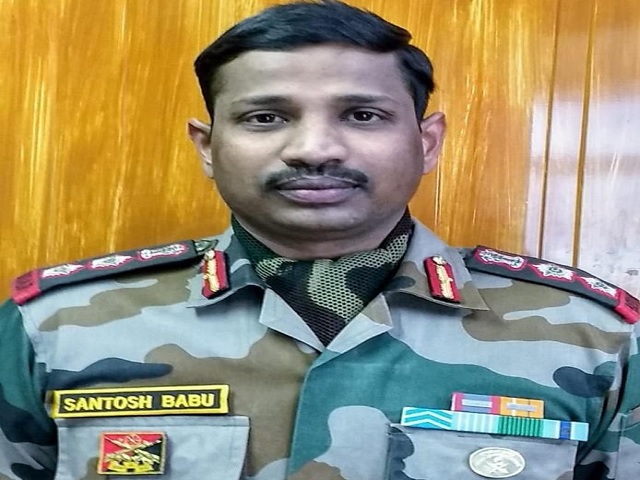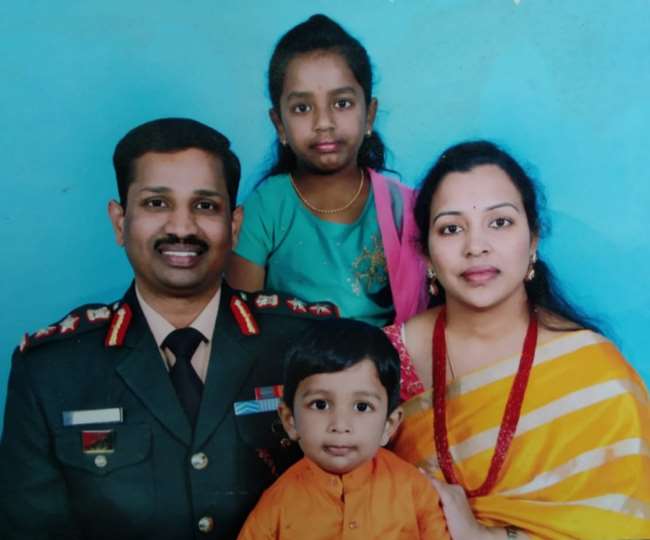Lt. General Shokin Chauhan: For years, China has flexed its muscles across the Indo-Pacific, building islands in the South China Sea, challenging boundaries in the Himalayas, and rewriting maps without prior notice.
While the world debated, they built roads. While diplomats discussed peace, they poured concrete, moved troops, and called it infrastructure.
Their belief was simple: India talks but doesn't act. That is when pressure mounts; we step back. That our silence is softness. Our patience is a weakness that no one will risk real resistance in the icy altitudes where treaties hang lighter than the air.
But history doesn't remember blueprints. It remembers the men who drew a line not on paper, but on rock, snow and blood.
And in June 2020, deep in the brutal, breathless heights of Galwan Valley, one such man stood unarmed but not unshielded. Behind him stood the honour of India.
The an Behind the Uniform: Colonel B. Santosh Babu

Nestled amid the arid plains and humming life of Suryapet, Colonel B. Santosh Babu's origins were as humble as they were quietly impressive. The stories that circulate about his hometown do not focus on dramatic outbursts or significant victories from childhood games.
Instead, people remember a child who exuded a quiet strength, the kind that doesn't seek attention but attracts others during times of need.
His friends often turned to him for guidance when the world seemed overwhelming, and even as a boy, there flickered behind his gaze the clear light of A purpose that would someday guide him into the uniform of the Indian Army.
In the years following India's independence, as border disputes and unresolved histories loomed large over the subcontinent, the allure and importance of national service continued to grow. For Santosh, there was never any doubt about the path he would follow.
The routine of early morning runs, careful preparation for each exam, and a strong sense of discipline developed under the open sky were not just steps toward a distant goal.
They were determined efforts aimed at fulfilling an unwavering dream: to serve the country and its people in the olive green uniform of the Indian Army.
A Leader with Empathy and Steadfastness
By 2004, that vision became his reality as he earned his commission and joined the 16 Bihar Regiment, a unit whose traditions reflected the storied, often tumultuous, arc of India's border guardianship.
In the intervening years, as India continued to navigate the complexities of its boundaries, especially along the high Himalayan frontiers of Ladakh and Arunachal, Santosh Babu established himself not as a man of grandstanding rhetoric but as a leader whose actions and demeanour calmed fears and inspired confidence.
The landscape of military command in these regions demanded not only strategic insight but also a deep empathy for the hardships endured by the men he led—a quality he possessed in abundance.
The Geostrategic Heartbeat of Galwan
It was this understanding and steadfastness that anchored him in the Galwan Valley by June 2020, a site defined by more than just topographical extremes or the beauty of its icy river snaking through stone.
A Legacy of Unresolved Claims
To fully grasp why Galwan's soil was so fiercely guarded and why a standoff here could ignite passions across two nations, it is necessary to examine the valley's geostrategic significance more closely.
Lying at the confluence of ancient trade arteries connecting the Indian subcontinent to Xinjiang and Tibet, the Galwan Valley has long played a pivotal role in defining the shifting frontiers of Central Asia.
In the nineteenth century, as the empires of Britain, China, and Russia competed for dominance in the region—a period known to historians as the "Great Game"—the ambiguity of territorial lines gave rise to a legacy of unresolved claims.
Yet for modern India, the valley's significance escalated after the 1962 Sino-Indian conflict, when it became both a literal and symbolic touchstone in the long and fraught process of marking sovereignty along the Line of Actual Control.
The Strategic Supply Line
The valley's strategic value was determined not just by its dramatic terrain but by its role as a natural corridor granting access to the vital Shyok River and its proximity to the Darbuk–Shyok–Daulat Beg Oldi road.
This all-weather supply line forms the backbone of India's effort to protect its northernmost airfield and remote posts at Daulat Beg Oldi, just a short distance from the Karakoram Pass.
Whoever dominates the commanding heights around the Galwan Valley can observe and, if necessary, hinder the movement of troops and materiel to this critical zone; it is here, between wind-whipped cliffs and glacial streams, that maps are not simply drawn but defended by blood and resolve.
For both India and China, each outpost or newly built track is not merely a tactical advantage—it is a marker of intent and control, a visible demonstration to the world of unyielding presence in the face of uncertainty.
The Fateful Night of June 15, 2020
A Cauldron of Mistrust
By the dawning of the fateful days in June 2020, this intensified competition had transformed the Galwan Valley into a cauldron of mistrust.
Senior officers, such as Colonel Santosh Babu, found themselves at the centre of not only a military contest but also a delicate diplomatic dance that required them to enforce disengagement agreements while projecting strength at every step.
The tension in the valley was not merely a local confrontation; it was a confluence of decades of border diplomacy, infrastructural leaps in the form of newly built roads, and the shared memory of 1962 that cast a long shadow over the men stationed there.
Confrontation and Unyielding Resolve
On the evening of June 15, as the sun dipped behind the jagged peaks and the Galwan River ran swift and cold, Colonel Santosh Babu led his men forward to ensure that a mutual agreement with the Chinese, requiring the removal of an unauthorised outpost, would be honoured in both letter and spirit.
Bound by a long-established protocol prohibiting the carriage of firearms during face-to-face boundary patrols, he and his troops advanced armed only with the authority of their leadership and the conviction of their cause.
The moment he found Chinese structures still standing, he responded not with anger but with uncompromised resolve, moving forward to confront the situation directly, his very posture declaring the ground not just as territory to be measured on a map but as the living embodiment of national dignity.
What followed was sudden and ferocious. The discussion deteriorated into an eruption of stones and improvised weapons wielded in the thin air and bitter cold. Amid the chaos, Colonel Babu's voice rose—firm, unswerving—urging, "Bihar Regiment, aage badho!"
Even as he suffered grievous wounds, he pressed on, not for personal glory or out of reflex, but because the weight of sovereignty and the honour of his regiment demanded nothing less. Through his courage, the men under his command drew strength and defiance, and the legend of that night was born—not in the tally of wounds inflicted or received, but in the refusal to be driven back or diminished, no matter how great the odds.
The Lasting Legacy of a Hero

A Nation's Pride and a Daughter's Salute
The news reverberated swiftly back to Suryapet and across the nation; in his home, grief was tempered by pride, as Colonel Babu's family—his wife Santoshi and their young children—stood before the cameras with the same quiet dignity that had defined his life.
His daughter's solemn salute to her father's photograph became, for millions, a symbol of sacrifice that does not end in loss but in the continuity of hope and patriotism.
A Watchword for Leadership
The honour bestowed upon Colonel Babu—the Maha Vir Chakra—was recognition from a grateful country, yet the words inscribed on the citation barely captured the measure of his leadership.
His regiment found inspiration not in speeches but in the memory of how he led from the front, standing resolute even when surrounded and wounded.
In one of his diary entries, later shared among his fellow officers, he distilled the essence of his philosophy: "Leadership in these times isn't about who speaks louder.
It's about who walks further, stays calmer, and faces the enemy with purpose. I tell my boys—if we stay true to our calling, history will take care of the rest."
Today, in the towns and training grounds of Telangana, in school assemblies and quiet battalion meetings across the country, the legacy of Colonel Santosh Babu lives as a standard for others to follow. There are new roads and statues in his name.
Still, perhaps his most actual memorial is found in the way the nation now looks upon Galwan Valley—with a deeper understanding that history and geography, strategy and sacrifice, are inseparable.
For in that narrow corridor of stone and river, where world powers still vie for the upper hand, the courage of one man and his regiment became a sentinel for Indian sovereignty, a reminder that sometimes, the defence of a nation's borders depends not on weapons alone but on the unbreakable spirit of those entrusted to stand their ground.
As long as the winds move across Galwan's icy expanse, carrying the echoes of footsteps that would not retreat, the name of Colonel Santosh Babu will stand as a watchword for the leadership, perseverance, and sacrifice that the defence of India's most contested horizon demands.
The Day India Rewrote Its Silence
In the shadow of those icy cliffs, on a night without bullets, India found its voice — not in anger, but in clarity.
A Moment of National Self-Definition
The Galwan incident was more than a military standoff; it was a moment of national self-definition.
For decades, India was perceived as a nation of restraint — soft-spoken and diplomatic, opting for de-escalation even when provoked. The world respected our democracy, our culture, and our economy. But they questioned our will — our red lines.
That changed in Galwan.
When Colonel Santosh Babu and his men stood their ground — without firearms, but with unshakeable resolve — it shook assumptions, not just across the border, but across the world. It showed that India's patience was a choice, not a weakness.
That peace was our priority, but not at the cost of principle. And that our silence, when broken, carries the full weight of a sovereign nation willing to defend every inch of its dignity.
A New Chapter of Pride and Purpose
Internally, it stirred something deeper. It reminded citizens that while we debate and disagree within, at the border, we are one.
That freedom isn't maintained by comfort but by courage. That the men in olive green don't just fight wars — they hold the line between chaos and civilisation.
Internationally, it changed the conversation. Strategic analysts, global powers, and even those who once doubted began to see India not just as a regional player but as a determined force that would not be pushed around. Our diplomatic posture grew firmer.
Our infrastructure race in border zones accelerated. And most importantly, the message was clear: the new India speaks softly but stands tall.
So yes — Galwan hurt. It broke hearts. But it also lit a flame.
A reminder to the world that we are not passive inheritors of our freedom — we are its fierce protectors. And in the silent snow of a lonely valley, a new chapter was written in India's story — one of pride, purpose, and presence.

Comments
All Comments (0)
Join the conversation